|
| |
| |
DENIS
GIFFORD'S
MONSTERS OF THE MOVIES
(1977)
|
|
Monster #12 -
The Creeper
|
|
| |
| |
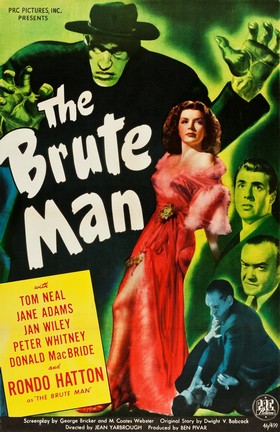 |
|

United
States, 1946
A Universal Pictures Production
58 mins, black & white, 1.37:1 aspect ratio,
35mm film
Director - Jean Yarbrough
Screenplay - George Bricker, M. Coates Webster
Original Story - Dwight V. Babcock
Cinematographer - Maury Gertsman
Production Design - John B. Goodman, Russell A.
Gausman
Makeup - Jack Pierce
Music - William Lava (uncredited)
Editing - Philip Cahn
Rondo
Hatton (Hal Moffat, the Creeper), Jan Wiley
(Virginia Rogers Scott), Tom Neal (Clifford
Scott), Jane Adams (Helen Paige), Donald MacBride
(Police Captain M. J. Donelly)
|
|
| |
| Some of the ghouls and scares
listed by Denis Gifford in his Monsters of the Movies
only scratched the surface of things. The format of the
little book and the limitations it imposed didn't really
allow for any background information at all - even more
so since the text served only as a recap of the movie's
storyline. In a few cases this made the
"monsters" somewhat puzzling and even difficult
to see as such; a prime example for such an entry is
Monster #12, "the Creeper" from The Brute
Man. |
| |
The features of Rondo
Hatton's face in the image seemed unusually
harsh, but even the classic upward lighting (you
knew how to do that to yourself with a
flashlight) couldn't quite produce something my
13-year old self at the time thought of as
particularly scary or even as being a
"monster". In short, I wasn't
impressed.
It was only a
week or so later, after having spent £2.95 at WH
Smith's for a copy of Gifford's Pictorial
History of Horror Movies, that I got a bit
of background information that actually did make
"the Creeper" seem creepy - albeit in a
very special sense.
"Rondo Hatton was the only
horror film star to play monsters without
makeup (...) Hatton suffered from acromegaly,
a distorting disease (...) [he] carved a
unique niche in the history of the horror
film. The only genuine monster star because
he was a monster." (Gifford, 1973)
|
|
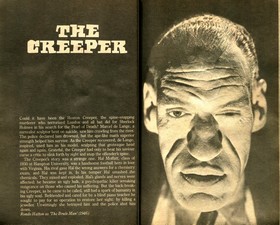
(Carousel Books / Transworld
Publishing)
|
|
| |
| Gifford's words come across today as extremely harsh
and devoid of any empathy. In part, this is due to the
fact that the 1970s were a very different time and age
when it came to physical afflictions, but it is also the
result of Gifford's style of writing, which often had the
staccato quality of a machine gun, as short sentence
followed upon short sentence. |
| |
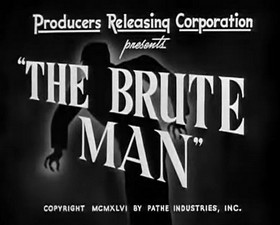
|
|
Gifford
thought nothing of The Brute Man,
calling it "a miserable film"
(Gifford, 1973). The inclusion of "the
Creeper" in Monsters of the Movies
could therefore rather feel like a "carnival
freak show" thrill - but it wasn't, since
the teenage readers of Monsters of the Movies
were not actually told about Hatton's disfiguring
illness. It simply remains an odd inclusion. There
are some conflicting ideas floating around as to
whether or not The Brute Man is in the
public domain, but there are enough indications
pointing in the direction that it is not -
notice, for example, the 1946 copyright
indication on the title card of the movie, also
used in the Castle Film (a Universal subsidiary
since 1947) 200ft home movie release of The
Brute Man. Accordingly, there have been a
number of DVD releases of somewhat dubious
pedigree over the past 30+ years but nothing in
recent years by any one of the reputable labels.
|
|
| |
| The Brute Man was filmed in 13 days, during
November 1945. Hatton's acromegaly was becoming
progressively worse by that time, making acting difficult
for him as he had trouble remembering his lines, focusing
on his performance, and responding to the other actors.
Jane Adams, who played the blind pianist, called him a
friendly and thoughtful man but pathetic to work with and
almost autistic (Weaver, Brunas & Brunas, 2007). |
| |
| Only a month
after filiming on The Brute Man was
completed, Hatton suffered a series of heart
attacks as a direct result of his acromegaly
condition, and passed away in February 1946
(Meehan, 2010), before the movie was even
released. Universal was about to merge with
International Pictures (and become
Universal-International in October 1946), and
adopted a policy of ceasing production of B
movies. As a consequence, the finished Brute
Man was sold to Producers Releasing
Corporation (PRC, the smallest and least
prestigious Hollywood Studio of the 1940s) for
$125,000, which covered the cost of the negative
plus interest on the money Universal had tied up
in the movie (NN, 1946).
Incidentally, this also made it PRC's most
expensive movie ever.
|
|
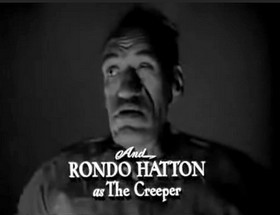
|
|
| |
| A theory that Universal worried that the exploitation
of the now deceased Hatton's condition could cause harm
to its corporate image seems rather unlikely, given
society's views on disabilities at the time. It is far
more likely that the film was an embarrassment due to the
poorly-developed story and inferior acting, and selling
it off was a way of avoiding the financial loss had it
simply been shelved. |
| |
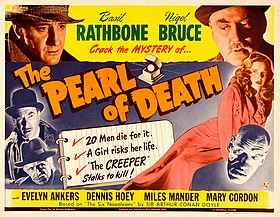
|
|
Gifford's
synopsis of the film in Monsters of the
Movies is actually comprised of plot
elements of no less than three different movies
that involve "the Creeper", but before
getting down to The Brute Man proper as
well as House of Horrors (to which The
Brute Man is a quasi-prequel), Gifford
starts out rather mysteriously with briefly
mentioning Sherlock Holmes, a "Hoxton
Creeper", and a Pearl of Death. I remember
that my 13-year old self was utterly confused at
the time. It simply made no sense at all without
further context - and that context is Universal's
1944 movie Sherlock Holmes and the Pearl Of
Death, starring the accomplished duo of
Basil Rathbone and Nigel Bruce as Holmes and
Watson. It also featured the "Hoxton Creeper",
played by Rondo Hatton; he only appears on screen
right at the end of the movie, but he looms large
throughout the movie.
|
|
| |
| Rather unsurprisingly, neither
House of Horrors
nor The Brute Man have any connection to Sherlock
Holmes and the Pearl Of Death - other of course than
having Hatton play a character named "Creeper"
in all three of them, providing almost identical visuals. |
"[Pearl of Death] was an
attempt by Universal to introduce him
as a new member of their monster
“family”, making this
possibly the only crossover between
the Holmes movies and their
traditional monster movie fare."
(Conliffe, 2013)
In that respect Gifford's decision to
include an innuendo to the Holmes movie
in his entry for "the Creeper"
in Monsters of the Movies makes
a strange inclusion seem even a bit more
odd. No surprise then that I remember
pretty much skipping over Monster #12
every time I took that little book from
the shelf.
Incidentally, the
£2.95 I paid at WH Smith's for Gifford's
seminal Pictorial History of Horror
Movies in 1977 equalled
£19.50 in 2021 (according to measuringworth.com),
illustrating just how intent I was on
breaking the bank in order to get that
book and learn more about horror movies.
It certainly cleared up things concerning
the "Creeper".
|
|

|
|
|
| |
| |
|
| |
| |
| |
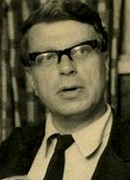 |
|
Denis Gifford on The
Brute Man
in A Pictorial History of
Horror Movies (1973)
"Rondo
Hatton and his Creeper brought the age of
Universal horror to an end. He died. His
miserable film shocked even the studio
that had made it. They disowned it,
giving it to the lowest of the low to
distribute. It went out on release as a
PRC picture: the ultimate horror."
|
|
 |
|
| |
|
| |
| |
| SOURCES CONLIFFE
Ciaran (2013) "Sherlock
Holmes and the Pearl Of Death (1944)", Daily
Scribbling, published online 15 June 2013
GIFFORD Denis
(1973) A Pictorial History of Horror Movies,
Hamlyn
MEHAN Paul (2010)
Horror Noir: Where Cinema's Dark Sisters Meet,
McFarland & Company
NN (1946) "U's
Brute Man to PRC But Hangs on to 2 Others", Variety,
23 october 1946
WEAVER Tom, John
Brunas & Michael Brunas (2007) Universal Horrors:
The Studio's Classic Films, 1931-1946 (2nd edition), McFarland &
Company
|
| |

Back
to main index page
|
| |
|
| |
The illustrations presented here are
copyright material.
Their reproduction in this non-commercial review
and research context is considered to be fair use
as set out by the U.S. Copyright Act of 1976, 17
U.S.C. par. 107
and in accordance with the the Berne Convention
for the Protection of Literary and
Artistic Works.
All images from
Monsters of the Movies
(Carousel/Transworld) were scanned from my
personal copy purchased in 1977
Page created 12
November 2023
Last updated 19 November 2023
(c)
2023

|
|
| |











